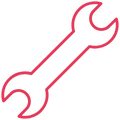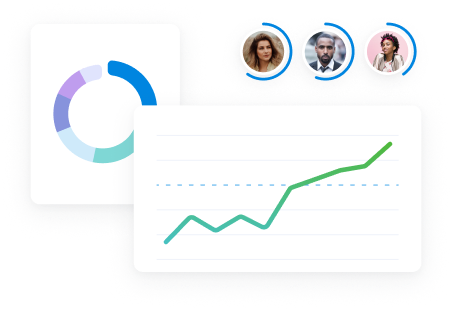Your tech stack is telling you something.
Every spreadsheet, free tool, workaround, and quick integration is a clue about how your business operates.
Over time, these small decisions compound. Creating a stack that’s harder to control, harder to trust, and harder to scale.
Harv Nagra, Head of Brand Comms at Scoro and host of The Handbook: The Ops Podcast, tech stack chaos is rarely accidental. It’s a reflection of your operational maturity.
The amount of chaos in your tech stack isn’t by accident. It reflects your level of operational maturity.
Harv calls the solution the “de-stacking” journey: the shift from scattered tools to a connected system that supports scale.
This article breaks down the five stages of that journey. What each stage looks like, which tools typically show up, and the specific moves firms make to progress.
Top Tip
If you’d rather hear Harv explain it himself, watch the full webinar recording below:
Stage 1–2: The Chaotic Era (and the Glimmers of Growth)
Your stack is messy because you’re in survival mode.
At this stage, tools multiply faster than results. You’ve got spreadsheets for everything—quoting, scheduling, time sheets, budget tracking, invoicing—and every team is doing their own thing.
Teams download whatever they need for whatever problem they have that week. You end up with an array of tools—and everyone doing their own kind of thing.
Your tools aren’t just simple. They’re inconsistent, disconnected, and mostly manual.
At this stage, the typical tech stack may look like this:
| Fucntion | Common approach |
|---|---|
| Core work management | Spreadsheets for task lists; Trello boards with no standard workflow; Asana Free used by 1–2 teams |
| Resourcing & scheduling | Capacity tracked in spreadsheets with color-coded cells; Float trial used ad-hoc for “who’s free” |
| Time tracking & billing | Harvest/Toggl/Clockify for time; invoices created by hand in Xero/QuickBooks |
| CRM & sales pipeline | Deals tracked in spreadsheets; HubSpot Free with no stages; Pipedrive Starter with inconsistent data |
| Finance & invoicing | Xero/QuickBooks with fully manual data entry; no link between time worked and invoices sent |
| Reporting & dashboards | Spreadsheet reports built from CSV exports from each tool; weekly manual reconciliation |
| Integrations & automation | Copy-paste is the “integration”; occasional one-way Zaps set up by one person |
| HR & people ops | No system; PTO tracked on spreadsheets or Slack messages |
Leading to the following symptoms:
- Manual data entry and copy-paste chaos
- Little visibility into capacity or profitability
- Projects overserviced without anyone noticing
Which means you’re probably running on hope more than insight.
Hoping invoices outpace overheads, hoping people aren’t overbooked, hoping spreadsheets are up to date.
Harv notes that 55% of professional services firms sit in these low-maturity stages.
How to progress at this stage:
Centralize the basics. One shared time tracker, one quote template, and a single source of truth for projects and resources. Even linking quotes to projects in a connected professional services automation (PSA) system like Scoro can cut hours of manual reconciliation.
Stage 3: The Stable Era
You’re no longer in chaos. But you’re still looking backward.
At this stage, you’ve achieved consolidation.
You have fewer, more thoughtfully chosen tools and documented processes. Work feels organized for the first time.
You’ve got fewer, more thoughtfully chosen tools — and documented best practices. But you’re still looking backwards at how you did last month, not forwards at what’s coming.
Your tools are “good,” but they’re still operating as separate islands. You’re organized, but not forward-looking.
At this stage, the typical tech stack may look like this:
| Function | Common tools |
|---|---|
| Core work management | Asana/Monday/ClickUp with standardized templates but still separate from budgeting or billing |
| Resourcing & scheduling | Float/Runn/Resource Guru used for planned schedules, but not updated when delivery shifts |
| Time tracking & billing | Harvest for time → Xero for invoicing, but no automatic link between logged hours and billables |
| CRM & sales pipeline | HubSpot/Salesforce for pipeline, but no downstream link to project budgets or resourcing |
| Finance & invoicing | Xero with partial automations (recurring invoices, bank rules) but no project-level financial roll-up |
| Reporting & dashboards | Spreadsheet roll-ups built from tool exports; dashboards updated monthly or weekly |
| Integrations & automation | Zapier/Make automations to push data between tools — but they break often or miss edge cases |
| HR & people ops | BambooHR for leave + basic sync into schedules, but no impact on project timelines or capacity |
Leading to the following symptoms:
- Visibility is still lagging — reports show what happened, not what’s coming
- Resource data gets out of sync when timelines shift
- Teams rely on gut feel to forecast workload
Harv estimates that 25% of professional services firms make it this far—and it’s a real milestone.
Real-world example: Kojo.
When Australian sport & entertainment agency Kojo hit 250 people, their stack (Accelo + spreadsheets + Xero) couldn’t keep up.
Quoting was slow and manual, reporting scattered, and finance lacked clear margin data.
After consolidating into Scoro + Xero, the team built standardized quoting templates, live budget visibility, and unified reporting—cutting 2–3 days off every quote and saving 1–2 days/month per user on reporting.
We can now get a quote to the client within 24 hours, including changes and internal vetting. We’d never be able to do this with any other system.
How to progress at this stage:
Connect quoting, scheduling, and billing so data flows between systems.
For example, a platform like Scoro can automatically turn approved quotes into projects with budgets, timelines, and tentative bookings, reducing manual effort and improving data accuracy.
Stage 4: The Data-Driven Era
You stop reporting on the past and start predicting the future.
This is where your tools begin to steer your business—not just record it.
Your systems are integrated, your data is reliable, and your leaders can finally forecast with confidence.
You’re no longer just guessing or relying on gut instinct—you’re able to forecast and navigate based on what’s actually coming.
Your systems are connected enough that you can predict workload, revenue, and margins instead of reacting.
At this stage, the typical tech stack may look like this:
| Function | Common tools |
|---|---|
| Core work management | A PSA like Scoro/Kantata/Productive running projects, budgets, deliverables, and financials in one workflow |
| Resourcing & scheduling | PSA scheduler tied to real project timelines; utilization updates automatically as work moves |
| Time tracking & billing | Time feeds directly into project budgets and billing rules; invoices generated from approved work |
| CRM & sales pipeline | HubSpot/Salesforce with 2-way sync to PSA; deal value, timelines, and resourcing push into forecasts |
| Finance & invoicing | Xero/QuickBooks/Sage Intacct fully connected to PSA; billing, expenses, and cost rates stay in sync |
| Reporting & dashboards | Real-time PSA dashboards; consolidated data in Power BI for weekly or daily leadership reviews |
| Integrations & automation | API-driven workflows keeping sales → delivery → finance aligned; minimal manual intervention |
| HR & people ops | BambooHR/Personio connected to PSA to auto-sync leave, availability, and employee records |
Leading to the following capabilities:
- Capacity and revenue forecasts update automatically
- Margins, utilization, and workload can be predicted 12–16 weeks ahead
- Hiring, pricing, and delivery decisions are based on real data
Harv says only 15% of firms ever reach this level of maturity.
Real-world example: DGA Group
A 380-person consultancy operating across 12 global offices, DGA used to juggle Maconomy, QuickBooks, and spreadsheets.
Disconnected systems meant manual invoicing, delayed reporting, and no single version of truth.
After moving to Scoro, they built a unified stack—Scoro + Expensify + Sage Intacct + Power BI—that gave leadership complete visibility into utilization, profitability, and cashflow.
How to progress at this stage:
Standardize quote and project templates. Automate alerts for margin risk or utilization thresholds. Use real-time resource planning tools to visualize capacity and spot issues early.
Stage 5: The Innovation Era
Your tech stack becomes an operating system for your business, and you can focus on innovation: around your offer and the client experience you provide – leaving the competition well behind.
At this stage, data entered once powers every workflow downstream — from quote to invoice. Everyone works from the same source of truth.
When you put data into a PSA platform, it gets reused throughout the system. You build a budget or quote, and that turns into your project, your resourcing plan, and your invoices.
Your stack is no longer a set of tools. It’s your operating system. Everything is connected, reusable, and automated.
At this stage, the typical tech stack may look like this:
| Function | Common tools |
|---|---|
| Core PSA platform | A single PSA (Scoro) powering quote-to-cash with shared budgets, timelines, costs, and reports |
| Resourcing & scheduling | Live resource planner + utilization heatmap; bookings and availability update in real time as projects shift |
| Time tracking & billing | Time → invoice automation; billable rules applied instantly; multi-entity and multi-currency supported |
| CRM & sales pipeline | CRM inside PSA or API-linked so opportunities automatically create resourcing forecasts and budgets |
| Finance & invoicing | Xero/QuickBooks/Intacct seamlessly integrated; supplier costs, PO flows, and inter-company billing automated |
| Reporting & dashboards | PSA dashboards feeding into a data warehouse (Snowflake/BigQuery); firm-wide KPIs updated live |
| Integrations & automation | PSA automation engine (Scoro MCP Server) orchestrating workflows across teams; Slack alerts for risks |
| HR & people ops | BambooHR/Personio connected to PSA to auto-sync leave, availability, and employee records |
Leading to the following advantages:
- Data reuse eliminates manual work
- Resource plans update live as projects shift
- Finance, operations, and delivery teams see the same numbers
Real-world example: Collaborate Global
When multi-office brand-experience agency Collaborate Global outgrew its patchwork of WorkflowMax, Smartsheet, Float, Xero, and spreadsheets, every report required manual reconciliation and visibility lagged behind delivery.
Moving to Scoro turned that sprawl into a connected operating system.
Quotes now feed projects, bookings, time, supplier POs, and invoices — all tied to Xero with inter-office billing and multi-currency support.
Finance, operations, and delivery now share one live data model.
Profitability and utilization are visible in real time; project reconciliation that used to take weeks now takes days, and the team saves 2 + days per month on reporting.
Scoro has become our source of truth. All financial workflows start in Scoro and then sync to our finance system. It’s really helped us streamline and centralize our tech stack when it comes to reporting across entities.
How to maintain this stage:
Run quarterly “stack audits” to retire redundant tools, automate handovers between departments, and focus dashboards on forward-looking KPIs.
Why you need to “de-stack” for growth
Even the best teams struggle when their tools don’t talk.
After all, most firms don’t break because of bad people or bad clients—they break because their systems can’t keep up.
Across every maturity stage, three weak links keep that chaos alive:
- Estimates vs. Project Tracking: Budgets live in one place, delivery in another. So overservicing stays hidden until it’s too late.
- Scheduling vs. Tracking: Timelines shift weekly, but disconnected systems don’t update capacity or forecasts. People end up overloaded, or sitting idle.
- Tracking vs. Invoicing: Manual billing means missed revenue. (One firm even tracked invoices in HubSpot — “super dangerous,” as Harv puts it.)
These aren’t small inefficiencies. They’re what quietly drain profit and create chaos as you scale.
And right now, that risk is amplified.
Pipelines are thinner. Deals take longer. Margins are tighter.
In that context, running with a fragmented stack isn’t just inefficient—it’s risky.
“When everyone sees the same data, it’s transformational. It seems like a hygiene factor, but it’s not normal — it puts you ahead of most businesses.
Even large consultancies spend heavily on internal comms teams just to paper over siloed systems.
A single connected platform removes that noise. It gives everyone one version of truth, one workflow, and one direction of travel.
In leaner times, visibility and efficiency aren’t optional. They’re survival.
And that’s exactly what de-stacking delivers.
Next Step: Find your maturity stage
If you’re unsure where your firm sits on the maturity curve, take Harv’s Business Maturity Assessment.
It’s acts as a diagnostic tool that pinpoints your stage and gives tailored recommendations to move forward. Whether you’re trying to clean up tool chaos, tighten processes, or build a fully connected system.






